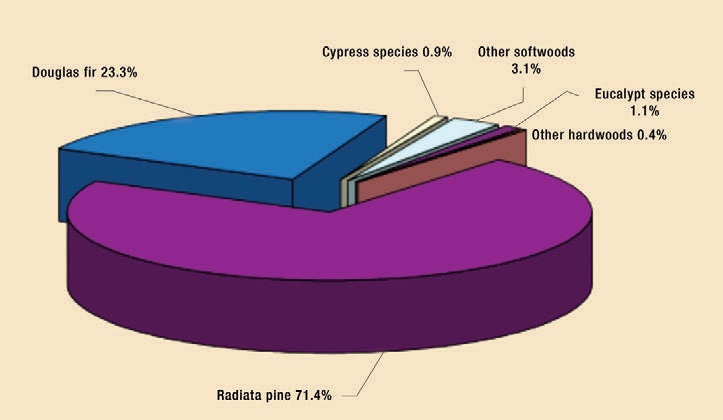The forestry scene in Otago
Mid Otago branch, New Zealand Tree Grower February 2011.
Otago has a rich forestry history, dating back 160 years. As early as 1849 a water-powered mill was operating on the Leith Stream to provide timber for the newly established settlement of Dunedin. The rapid growth of the city in the years following European settlement, and the Central Otago gold rush, created a strong demand for timber. This demand was met in large part from the natural forests of south-east Otago. Sawmilling operations began at Tapanui in 1860 and were followed by operations in the Catlins. During the 1870s a total of 20 sawmills operated in the Catlins area.
Otago and Southland were at the forefront of bringing mechanised paper manufacturing to New Zealand, with the establishment of the Woodhaugh mill in Dunedin and the Mataura operation in Central Southland in 1876. The early European settlers brought a range of tree species to Otago, and these are now features of the landscape. The experimentation with new plantings continues to this day, and appears in the diversity of plantings that can be seen on farms and in public spaces.
The region’s exotic plantations have their origins in the late 1890s. Nurseries were established at Ranfurly and at Tapanui in 1896 and 1897. The first substantial plantings were developed at Naseby Forest and Conical Hill in 1900 and 1903 respectively. These forests are now some of the oldest plantations in New Zealand. Production trials on the timber began in 1933, and in 1948 the Forest Service started the construction of the Conical Hill sawmill as a demonstration unit for processing plantation timber.
Forestry today
Otago’s planted forests now stand at 124,700 hectares, or just over seven per cent of the national total. More than a third of this area has been added since 1991. An important feature of this increase has been the significant investment in Douglas fir. Douglas fir accounts for just over six per cent of national plantings, but is 23 per cent of the Otago resource. This is a long term investment in a species with an established international reputation. For the region’s growers and processors, the Douglas fir resource provides opportunities to develop new markets and product lines. Harvest volumes are forecast to climb in 12 to 15 years time.

While not on the same scale, the region also has a significant cypress resource, second in area to the West Coast, and it has been developed by both corporate and private investors. The cypress plantings are mainly macrocarpa and have been made over the past 25 years. This resource has potential for furniture manufacturing and other high value end uses.
The grower interest in Douglas fir and alternative commercial species means that Otago has a substantially lower proportion of its land in radiata pine than the national average. Just 71 per cent is in radiata compared to almost 90 per cent nationally.
Major forestry investment
At a district level, Clutha stands out as the principal area of forestry activity, with almost two-thirds of all plantings, both corporate and private investment.This has been due to a combination of factors, which include an established processing industry, favourable growing conditions, good quality infrastructure, a council that has been supportive of primary sector investment and the availability of land. The district will provide the majority of Otago’s increased radiata volumes from the middle of this decade and the growth in Douglas fir production from the mid 2020s.
While Clutha dominates the regional statistics, Central Otago and Waitaki have seen major investment in forestry activity over the past 15 to 20 years. Central Otago forestry has grown on the back of Douglas fir development with 45 per cent of the plantings in the district now being Douglas fir.
Diversity of ownership
Otago’s forests are characterised by a widely dispersed ownership structure. The region has 10 forestry companies who manage more than 1,000 hectares of plantings and a third of the estate is in the hands of small to medium sized owners. The principal companies operating in the region are Blakely Pacific, City Forests, Ernslaw One, Matariki Forests and Wenita Forest Products.
Timber processing

Timber processors from both Otago and Southland compete for the region’s log supply. It is not uncommon for logs to be transported from Clutha and Dunedin through to Invercargill or Winton. This benefits growers as it provides a wider range of processing options and builds a more competitive environment.
While there have been several mill closures in recent years, there are a dozen facilities in Otago and Southland producing 5,000 to over 100,000 cubic metres of sawn timber each year. In addition to this, there are a number of smaller portable and fixed mills.
A significant proportion of the region’s pulp logs and sawmill residues are processed into medium density fibreboard, at the Dongwha Patinna facility at Mataura. Another important end use for the harvest is veneer production by Southland Veneers, near Invercargill. In terms of further processing, Southern Cross Forest Products operates a wood mouldings facility at Mosgiel. Collectively, these processors normally handle 70 to 75 per cent of the annual harvest, with the remainder being exported as logs. With this range of mills and processing activities there is a good level of competition for log supply. The current demand for logs from China and other Asian markets has resulted in higher than normal volumes going across the wharf. In the year ending June 2010, 464,000 cubic metres of logs left the wharf compared to more traditional levels of 250,000 to 350,000 cubic metres a year.

 Farm Forestry New Zealand
Farm Forestry New Zealand